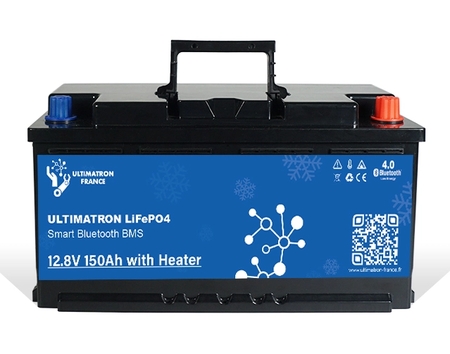Before choosing the leaders among the best lithium iron phosphate batteries, we will tell you how these models differ from others, what their advantages are, and what special characteristics they have. Of course, all of presented lithium batteries will be described in more detail in the relevant sections.
TOP LiFePO4 Battery 12.8V
Here’s the models we will be discussing:
Ultimatron LiFePO4 Lithium Battery 12.8V 100Ah
With Bluetooth And Smart BMS Integrated And Heater

- Battery capacity, Ah - 100
- Voltage, V DC - 12.8
- L x W x H, mm - 355*175*188
- Battery type - Lithium
- BMS - Yes
- Bluetooth - Yes
- Brand - Ultimatron France
- MPN - ULS-12-100H
Ecowatt LiFePO4 Lithium Battery 12.8V 100Ah

- Battery capacity, Ah - 100
- Voltage, V DC - 12.8
- Energy - 1280 Wh
- L x W x H, mm - 330*172*215
- Battery type - Lithium
- BMS - Yes
- Brand - Ultimatron France
- MPN - ECO-12-100
Victron Energy SuperPack 12.8V/100Ah

- Battery capacity, Ah - 100
- Voltage, V DC - 12.8
- L x W x H, mm - 330*172*220
- Battery type - Lithium
- BMS - No
- Energy - 1280 Wh
- Brand - Victron Energy
- MPN - BAT512110710
Ultimatron LiFePO4 Lithium Battery 12.8V 150Ah
With Bluetooth And Smart BMS Integrated And Heater

- Battery capacity, Ah - 150
- Voltage, V DC - 12.8
- L x W x H, mm - 355*175*188
- Battery type - Lithium
- BMS - Yes
- Bluetooth - Yes
- Brand - Ultimatron France
- MPN - ULS-12-150H
ReLion RB100-HP Battery 12.8V 100Ah

- Battery capacity, Ah - 100
- Voltage, V DC - 12.8
- L x W x H, mm - 329*172*214.7
- Battery type - Lithium
- BMS - Yes
- Battery-connection - M8
- Brand - ReLion
- Code - 3940908
Pros Of Lithium Iron Phosphate Batteries
In such power supplies, lithium iron phosphate is used as the cathode material. The anode is made of carbon, like other lithium cells. Compared to LFP counterparts, batteries have superior chemical and thermal stability, resulting in the following advantages:
- they are as safe as possible to use - they do not ignite or explode, even if depressurized;
- practically do not emit toxins, which facilitates their disposal;
- more resistant to overcharging, short circuits and other emergency situations;
- not prone to avalanche-like destruction in case of overheating;
- withstands peak discharge currents of up to 25 C without critical consequences;
- withstand prolonged exposure to high voltage;
- durable - the service life of LFP batteries is at least 2000 operating cycles with a reduction in the original capacity by 20%;
- suitable for use in equipment with high current loads;
- have low self-discharge;
- frost-resistant;
- work stably at temperatures from -30 to +50 °C;
- do not have a pronounced memory effect;
- when discharged they have a stable voltage;
- allow fast charging with high currents;
- less susceptible to the aging effect - the natural decrease in capacity for LFP cells is only 1.5% per year, while for other Li-ion cells aging is observed at 10% per year.
These advantages of LiFePO4 batteries have a positive impact on their technical characteristics:
- nominal voltage 3–3.3 V;
- voltage limit values – 2 V and 3.65 V (for some models – 2 V and 3.9 V);
- voltage under load, minimum – 2.8 V;
- voltage at midpoint - 3.3 V;
- capacity – from 2500 to 6000 mAh and above, depending on the cell size;
- resource – more than 2000 cycles;
- specific power – 90–120 Wh /kg;
- typical charge current is 1C, within 3 hours the charge increases to a voltage of 3.65 V;
- self-discharge – up to 5% per year.
Depending on the number and connection diagram of the cells, the battery parameters vary: the battery capacity can reach 2000 Ah, the voltage is usually 12, 24, 36, 48 or 72 V. The operating temperature range of LiFePO4 batteries corresponds to the cell parameters (from -30 to +50 °C), and the charging current varies from 4 to 30 A.
The connection diagram of lithium ferrophosphate batteries in the assembly depends on the required capacity and voltage parameters. When cells are connected in series, the capacitance does not change, but the voltage is summed. When connecting them in parallel, the voltage does not change, but the capacitance is summed up. For stable operation of the battery, BMS boards are used to protect power supplies from overcharging, deep discharge and short circuits.
Areas of Use
LFP batteries are used in various fields, including as batteries for boats and other types of water transport equipped with electric motors, as well as buffer energy storage devices in alternative energy systems - like autonomous power supply using solar panels and wind generators, which has become common in the production of not only pleasure yachts, but also racing models.
Of course, lithium ferrophosphate batteries are widely used in everyday life - to power electric motors of bicycles, scooters, mopeds, motorcycles, electric vehicles, ATVs and other electric vehicles; for equipping electric lifts, vacuum cleaners, stackers, loaders, reach trucks, floor scrubbers, golf carts, lawn mowers and other equipment; as part of home UPS; for completing hybrid generators, weather stations, gaming equipment and other devices.
Charging Features
The BMS protection board prevents overcharging of the battery, its deep discharge and short circuit, and also balances the batteries - equalizes their voltage. But unprotected batteries (without a protection board) cannot be recharged or discharged below the permissible limit, otherwise they will degrade and lose their functionality.
If discharged batteries are left without recharging, a further decrease in voltage as a result of self-discharge will negatively affect the capacity and performance of the power source. Charging should be carried out at a case temperature close to room temperature. To avoid overheating, the battery and charger being charged must not be covered with anything.
The process of charging LFP batteries and accumulators includes 2 stages:
- Direct current to the desired voltage.
- At constant voltage to the minimum charging current, according to the CC/CV algorithm.
For charging, it is recommended to use smart chargers. The optimal charge voltage is 3.6-3.65 V per cell. The result is a voltage of up to 3.4–3.45 V per battery.
Storage and Disposal Rules
Before long-term storage, LiFePO4 batteries must be charged to 40–60% to prevent significant discharge and loss of capacity. It is recommended to store power supplies at temperatures from +5 to +30 °C, in a dry place, away from heat sources and direct sunlight.
It is advisable to recycle batteries that have exhausted their service life. At special recycling points, power sources are disassembled and subsequently used, for example, to assemble blocks for storing electricity from solar panels, wind turbines and compact hydroelectric power plants.








